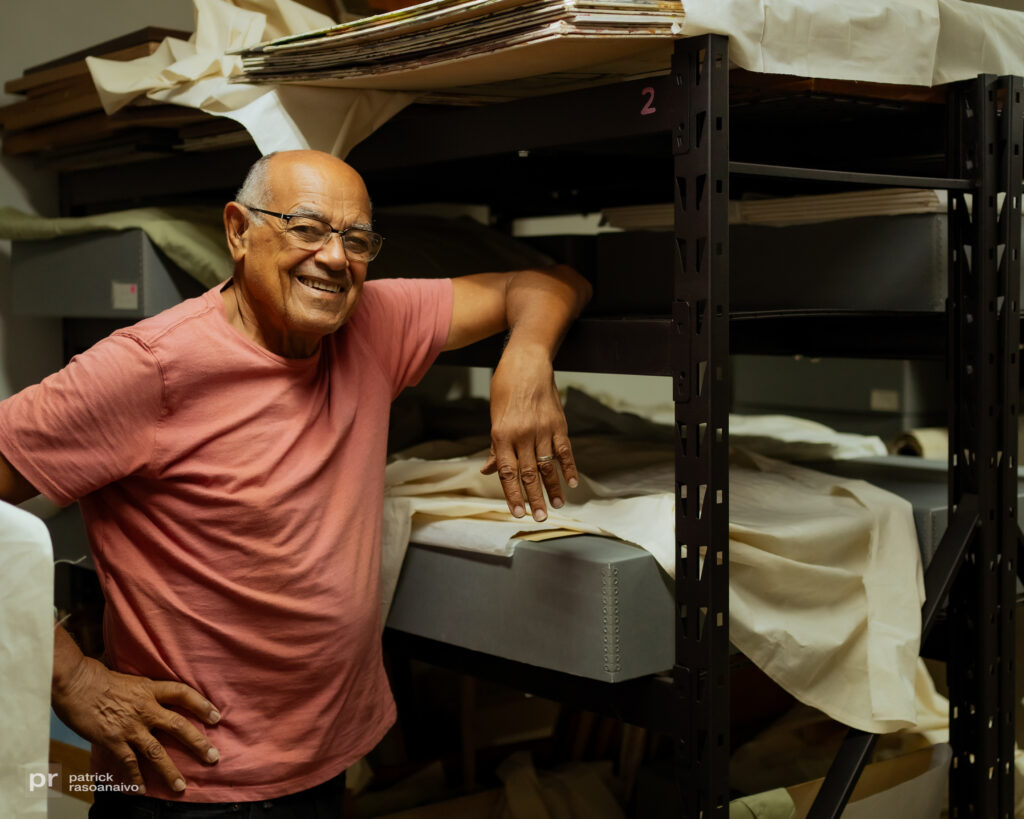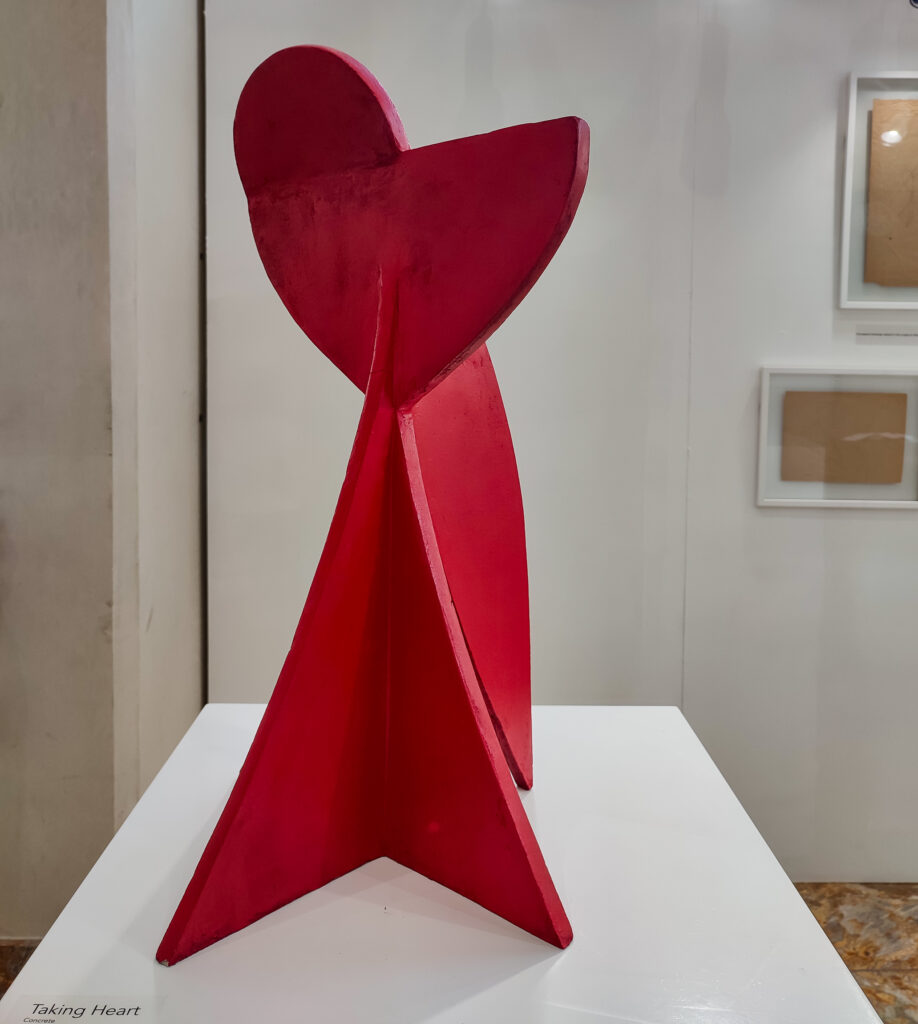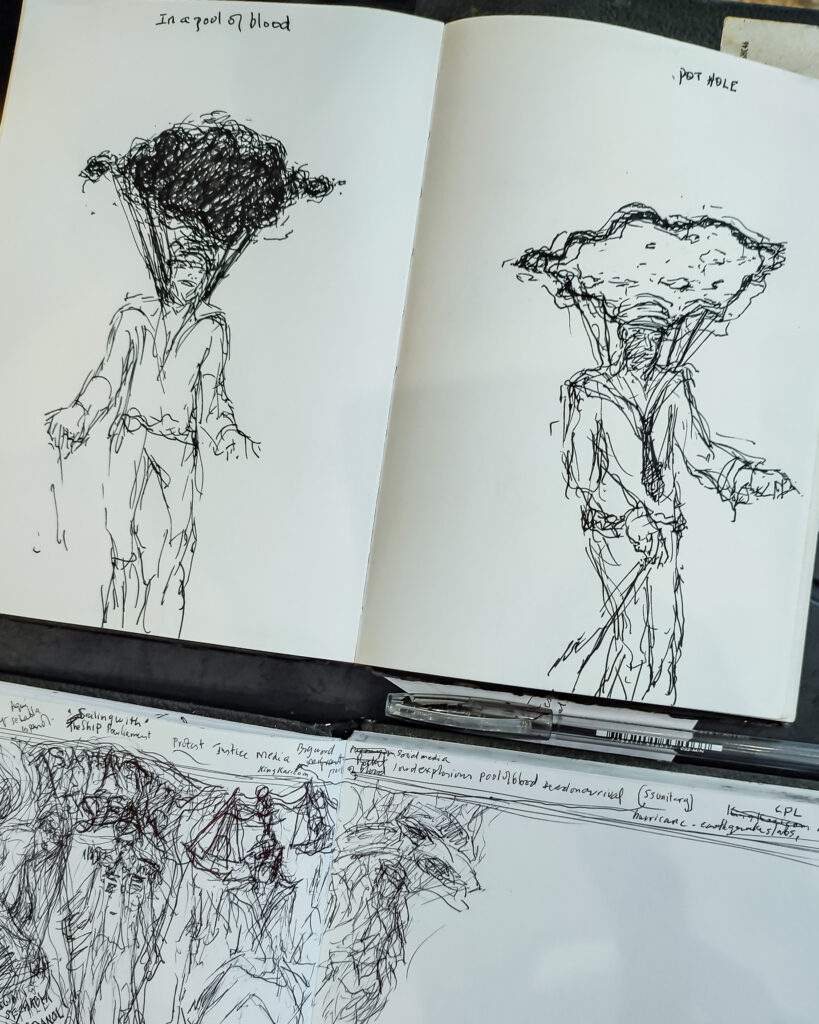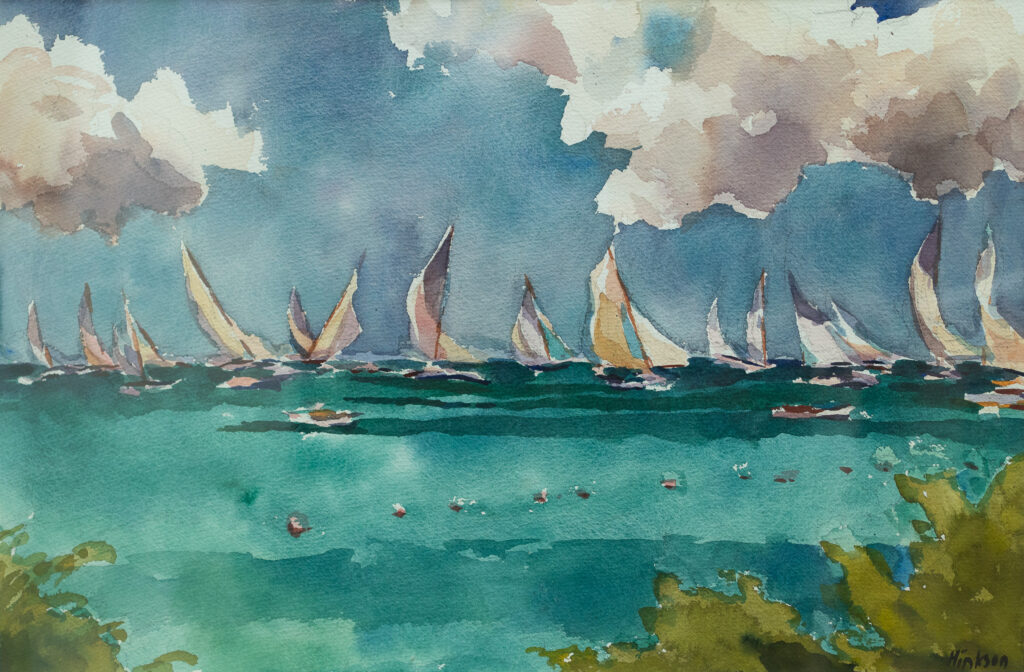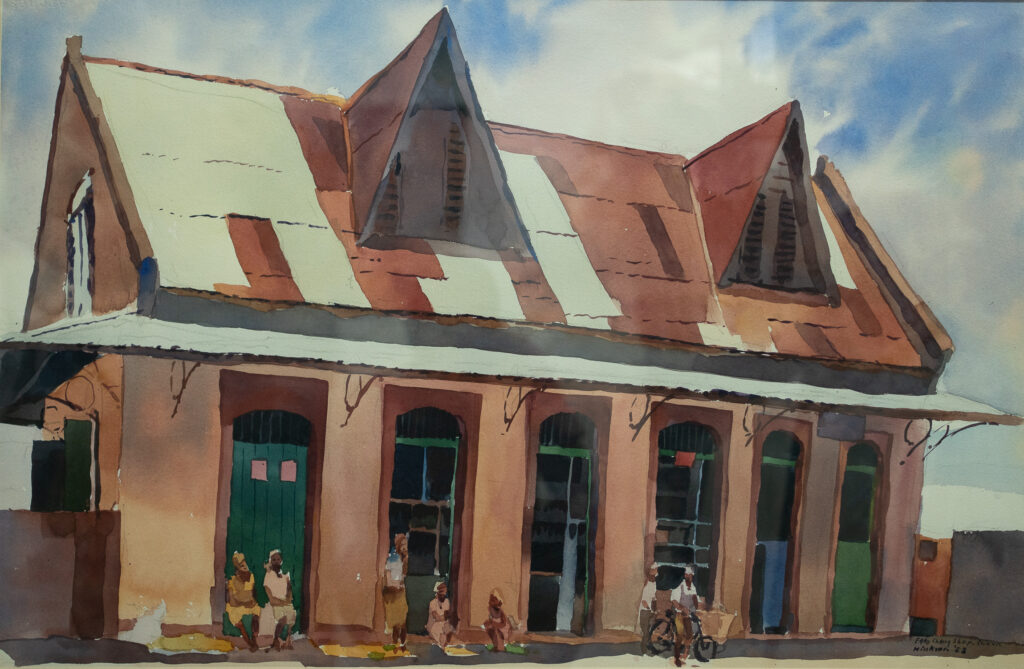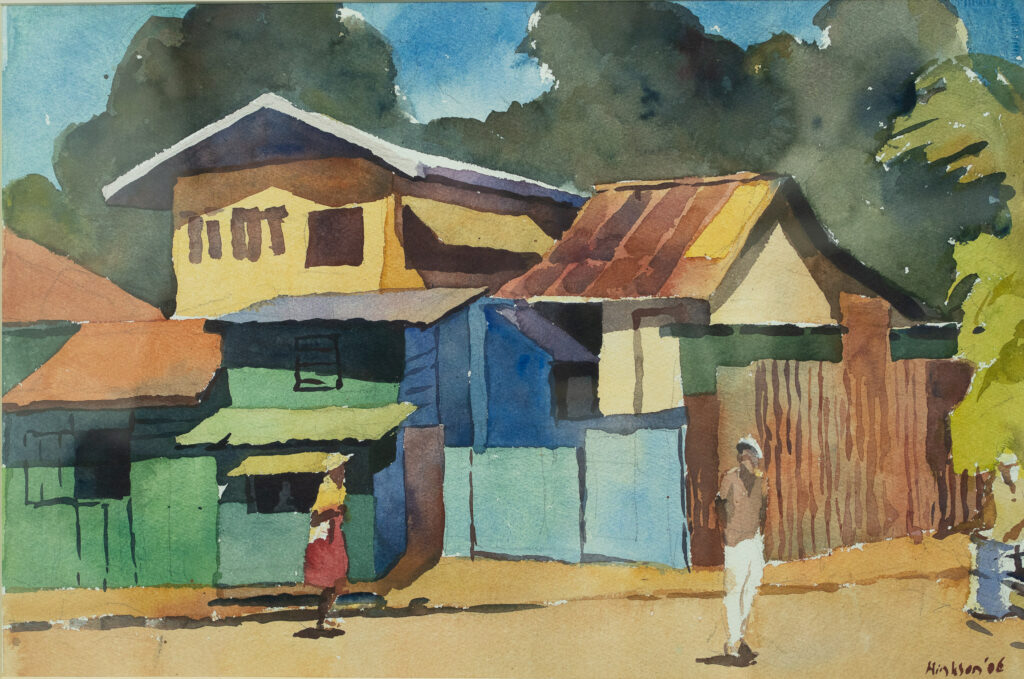Interview with Artist Jackie Hinkson
My story with Jackie Hinkson began over 30 years ago. I keep close vivid memories of flipping through large calendars featuring the most luminous and vibrant watercolour paintings of Caribbean landscapes and seascapes printed by an insurance company at that time I believe. The paper stock for these calendars was thick and textured, with the distinct scent of fresh new school books.
Growing up in the small sleepy and uneventful area of D’Abadie, when my dad brought these calendars home, they would just light up our world. At the end of the year, I would even cut out the paintings, and repurpose them, sticking each one as “a painting” to decorate our bedroom walls…that Art was life.
As I look back, even though I did not realize it, those paintings, albeit from a calendar, provided a big escape for me, beyond my tiresome routine of school-home-church-public transport commuting. These images, windows to another world, were images of my own island country – but much more exciting and filled with movement – as seen, and re-created by a well-known Artist somewhere.
At that time I had never seen an image of Jackie Hinkson (let alone even entertain the thought – that one day I’d grow up and meet him) but the style of his shaky, painterly signature, his name mentioned as one of the Trinbagonian artists we needed to know about (alongside Carlisle Chang, Sybil Atteck, Ken Crichlow, Lisa O’Connor, Carlisle Harris, Pat Bishop, Makemba Kunle, Sundiata, Tonia St. Cyr, Adele Todd…) sure, I’d remember that.
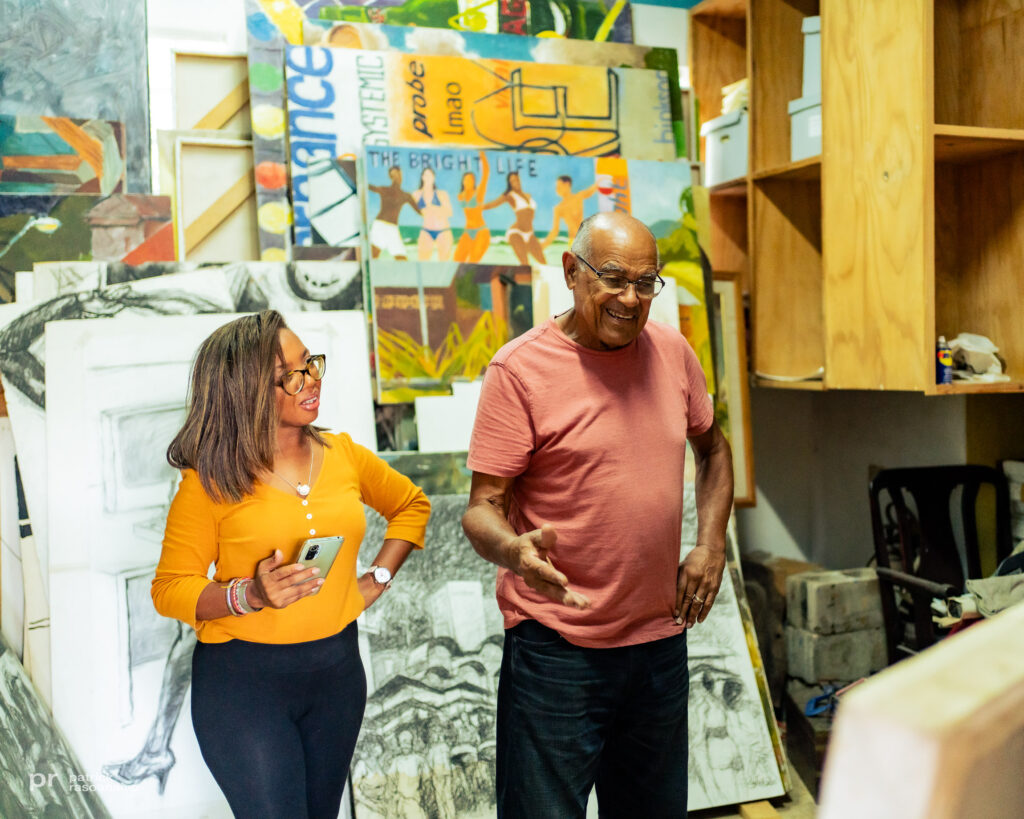
Is that what inception is? Yes, I think so AND Art Education too. The collaboration (read investment and mutual understanding of Art’s impact on a societal level) between a corporate entity with an artist, to feature local paintings throughout the year in a mass produced, calendar format and further gift it to their client base (free of charge), not only was an excellent PR campaign, but it filled many homes, like mine – with Art.
Via this initiative or what we’d call a CSR project these days, Art was made accessible to a larger public at that time – who would probably never make it to a museum or a glamorous “big shot” Art gallery in Port of Spain or anywhere else for that matter due to societal hierarchy. At least, via a simple calendar, we could touch a painting, enjoy beauty and dream as freely as we needed to.
I have no doubt that this “exposure” to Art from an early age, made me eager to embrace my “artistic side” and from the age of 10-11 years, I excelled at Art throughout secondary school. It was just one of those subjects I knew I mastered, effortlessly. Naturally? Inherited? Learnt? I am not sure, I just remember that I could not wait for art class, to let my imagination roam, pour out my heart, and just create the things I wanted to see.
10 to 42. That’s 32 of my years with Art on my mind.
Donald “Jackie” Hinkson has been living this Art Life for the past 60 plus years.
His most recent show of sculptures at the Central Bank Museum: Taking Shape was just spectacular and moved me beyond words. I teared up as I saw a younger version of Jackie, seated near to one of his first sculptures back in 1967- 68 while at University in Alberta, Canada (he replicated it for this exhibition: a rich smooth cobalt blue, stretched triangular structure, made with resin, which he’s now named The Prow, 2023) – the same posture, eyes interrogating and observing, an inviting calm. Hinkson’s sculptures, now in the physical – were first conceived as ideas, explorations back in the 60’s and 70’s, as simple pencil sketches, revisited lines, abstract shapes carefully tucked away, now mounted – 60 years later – by the Museum’s curatorial team.
1968. There is something profoundly incredible about being in the presence of a thin yellowed paper drawing done before you were even born. It says alot about the passage of time. How memories and stories are preserved through artists and artmakers everywhere. The phenomenal value of artists in our societies to imagine things and bring them into the physical sensory space, in the here and now, to endlessly surprise us….
The idea of Jackie in his studio at 81 years old, CO-MMITT-ED to making art and doing something else (not at all the paintings and drawings he’s known for) made one thing clear: That is the work of a lifelong artist. Years of thinking, years of sketching, imagining things that don’t exist, but will one day…at the very least, that’s a relentless belief in Life, and the future.
At the time of our conversation, I met Jackie sketching in the exhibition area of the CBMuseum, completely absorbed in his sketchpad, his black ink pen gliding feverishly across the white surface of his little book…. We chat for a bit, then he tells me about his big dream: To collaborate with an architect to build larger than life sculptures of the pieces seen in this show, installed in a public space. I tell him that’s what I saw too: these sculptures have a contagious playfulness to them. Within minutes I found myself thinking how amazingggg it would be to enter, to roam and be totally welcomed, protected by and see myself as a passenger navigating these pieces. To look up and lose myself in the light and shadows of unpredictable curves, wildly sharp geometry…a transformation for me, for us and the space-s around.
I can see it already. I know there are folks out there who long to see a sculptural park, filled with incredible Art – right here in Trinidad & Tobago, inspired by one of our most prolific, unwavering and socially engaged artists, Jackie Hinkson.
INTERVIEW
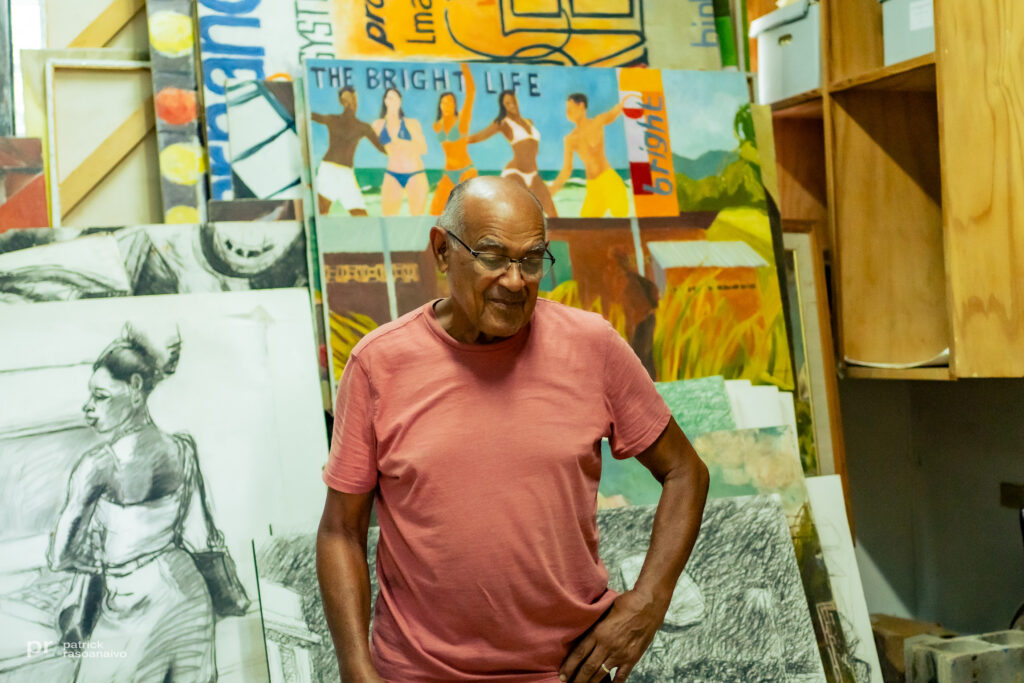
Adeline Gregoire: Jackie you are approaching 60 years as a career artist based in Trinidad and Tobago, as you look back with Art as a career path – how would you describe it?
Jackie Hinkson: As constant hard work with occasional moments of satisfaction. I see it as a continuing journey, not as something that I look back on. My focus is on moving forward, knowing that I will never reach a pinnacle.
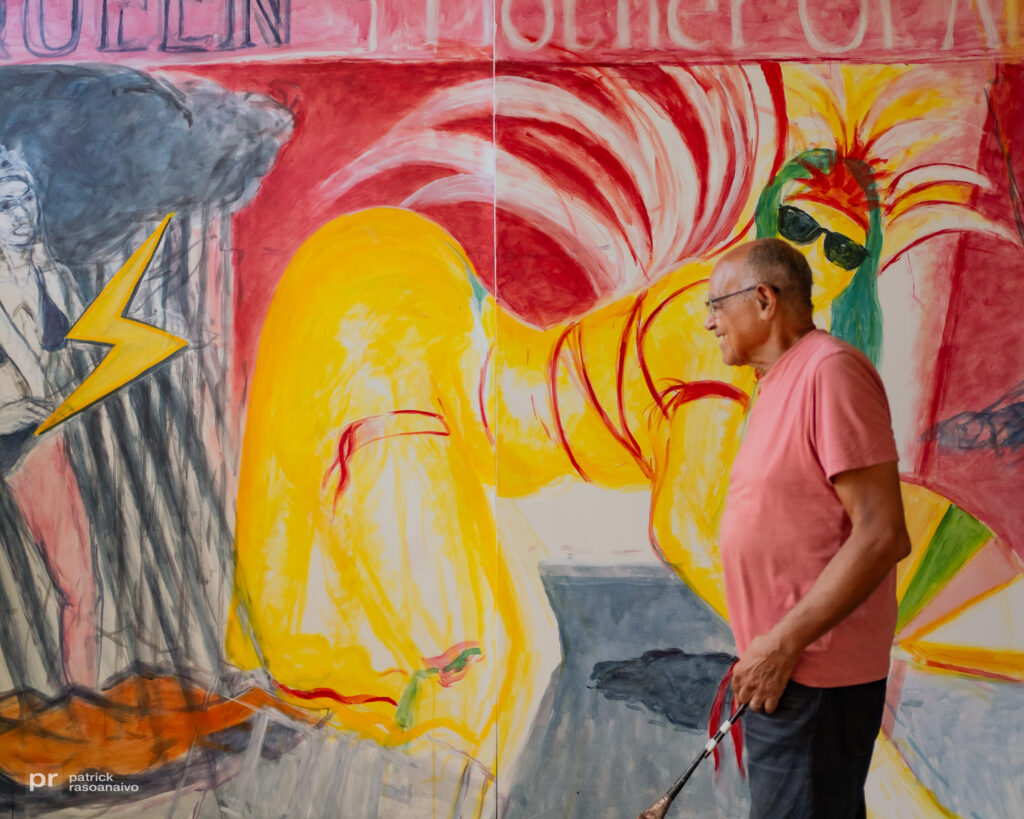
AG: How did you do it? What kept and keeps you inspired?
JH: I do not know why I am driven to do what I do. It is a reality that I accept with gratitude. I think the inspiration comes from just being alive and experiencing and observing life, the human condition. The rest is work and the discipline of work.
A life filled with Art is simply one that is dedicated through constant lifelong work, to the pursuit of one’s vision of the world.
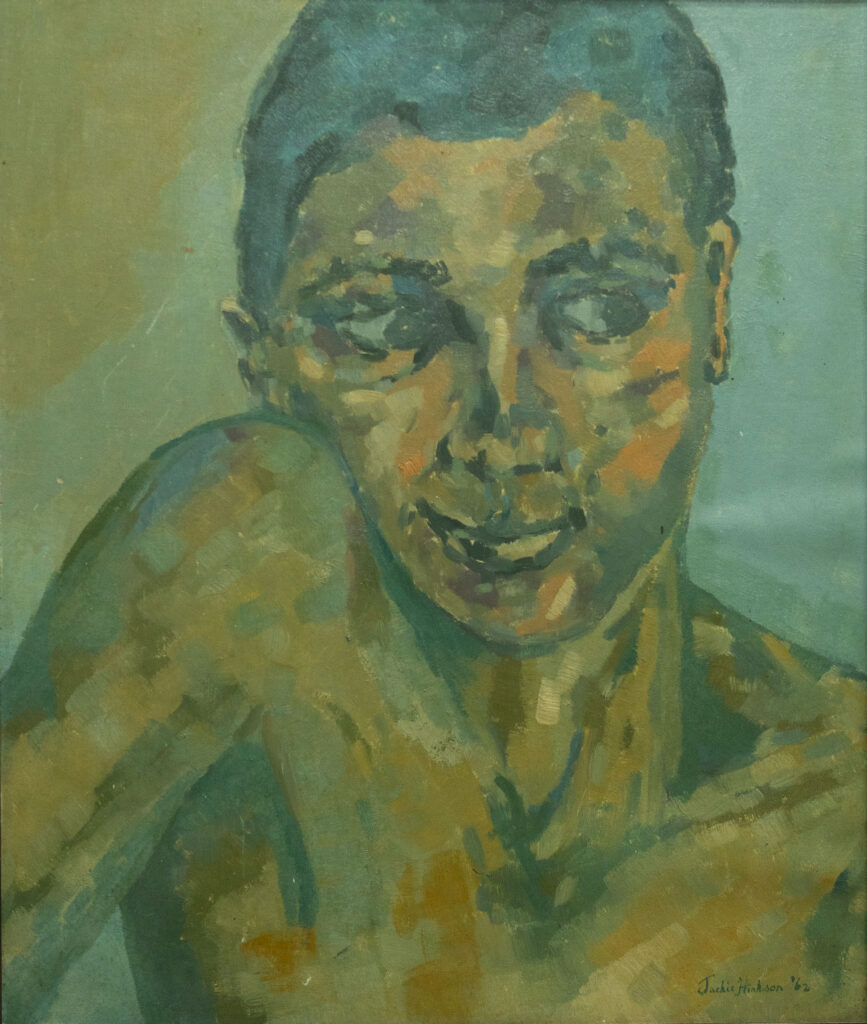
AG: What are the challenges or obstacles that you have encountered?
JH: They are, not unexpectedly, numerous. After all this is not a commonly pursued career. They also vary from stage to stage in one’s career and from era to era. I’ll list some:
MATERIALS.
Understandably, we professional artists here (Trinidad & Tobago) depend almost totally on imported materials. This is a constant challenge. Availability. Costs.
FINANCIAL SURVIVAL
Art is not widely considered an essential ‘service’ so income from it is unpredictable. Of course there are collectors some of whom are discernible and some, often willing to spend big, who are not and satisfy their tastes. Sadly, Art dealers sometimes exploit this reality resulting in inexplicable discrepancies in the pricing of art, even in one artist’s work. This is a reality not a criticism.
Some 37 years ago, with a wife, three young teenage children, a house and mortgage, I decided to quit teaching to become a full time professional Artist. The challenge was how to survive. Fortunately for me I had spent more than a decade working at my art and at slowly building a reputation through exhibitions. Equally fortunate was the fact that at the time, I was producing a lot of plein-air work, a genre more likely to attract buyers. Decades later I received generous corporate support, but the situation remains unpredictable especially with the country’s declining economic fortunes. No wonder very few are willing to make the move that I made some four decades ago.
The more art that is bought the better it is for the entire art community and industry: for artists, galleries, suppliers of materials, art framers and everyone else.
THE MEDIA, PUBLIC EDUCATION
One of the biggest tragedies to me (and it is a challenge) in the present art scene here in T&T, is the serious, unpardonable decline in the quality of Art exhibition coverage in the media. 60 years ago – true the art world was smaller then – every Art exhibition was reviewed in a knowledgeable way that informed and educated the public even if some were not in agreement with the critic. Since then, more and more, the emphasis has shifted to spectacularly superficial or biased reporting. Today, most of the time the artist or the gallery must bring a package to the media house where the ‘reviewer’ is not qualified to review, where the emphasis is on photos and names of persons attending, where connections in the press are necessary, where the artist speaks in praise of their own work and where the public, sadly, is not being enlightened.
POLITICS IN THE ART COMMUNITY.
Around 1960 when I was a very young member of the Art Society I had the impression that the small art community genuinely shared common goals. Was I naive? Not once did I see a sign of power politics, of self promotion to the disadvantage of others, of disrespect. In the 1970s I was in a joint exhibition with Boodhoo, Chu Foon and others. Our aim was to bring art done in a range of styles to a wider public – together. How things have changed!
Somewhere in the 80s, I feel as though cliques began to form, who belonged to what group became important, who was more contemporary, connections in the media, with funding, even ethnicity… Some artists would not go to the exhibitions of others who worked in a different ‘style’. Artists were being pigeonholed. And no one in the media educated the public through this mess. Of course as societies, technology and everything else evolves, as will visual expression, styles etc.
But we have to be taught, and to understand that good art produced centuries ago is no less ‘relevant’ (whatever that means) than good art produced now. A personal experience: I practiced, and still do, the traditional genre of plein air painting but I also work with other mediums. A few years ago a university art student who was familiar with my plein air work said to me when she saw my digital iPad work: “oh! I didn’t know you did contemporary art “. I guess one day I am traditional and the following day contemporary. We all know that the adjective ‘contemporary’ can be meaningfully applied but never as a synonym for relevant, or worse, superior.
CLIMATE
The harmful effect of tropical heat, humidity and UV light has been a huge challenge for me. Unfortunately I discovered these dangers too late, after hundreds of my works on paper, drawings and watercolours, were irretrievably damaged. To this day the damage continues as many collectors remain unaware. Fortunately art framers are more knowledgeable now although some collectors are very slow to respond. I have noted that all of my works abroad are in pristine condition. Is it because of temperature, humidity, severity of UV light, quality of framing, use of materials with acid in them or all of the above?
AG: I know you’re not a fan of “labels” “-isms” and “movements” used to categorize Art and artists. How would you describe your Art work and Art practice ?
I would like to reach as wide a public as possible but not at the expense of compromising the full integrity of my work.
JH: There are so many aspects to my work, I’ve used many mediums and my art has fluctuated from brief spells of abstraction to recognizable imagery. I have always admired (envied?) the easy relationship calypsonians have with the public and would like to reach as wide a public as possible, but not at the expense of compromising the full integrity of my work. I think this is why I try to keep my images recognizable but pay very very strict attention to the formal handling of the visual components: shape, tone, line, space, light and how they interrelate. In short I’m always focused on the more ‘abstract’ element in my art.
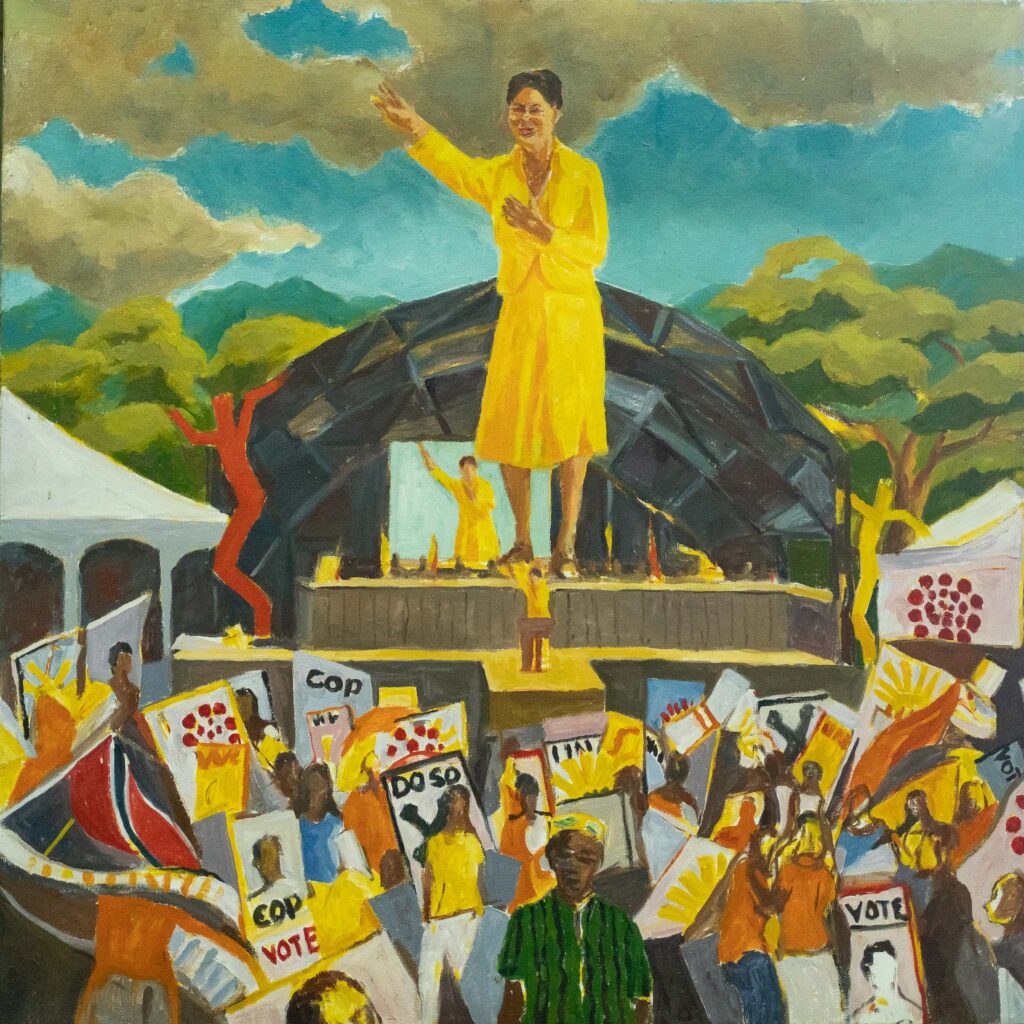
AG: Your work reads as a constant documentation of people you’ve seen, social commentary and capturing moments. Who are these people whom you choose to draw/ paint ?
JH: I very rarely analyze my work at the level of narrative meanings: why this figure here? Or why is this man there? etc. I prefer to look more critically at my handling of the formal visual elements and let the narrative emerge intuitively. Sometimes though, I do look back at my work and wonder about the significance of the human figure in my work. It strikes me that whenever I depict a mature woman she appears to be busy, on the way to getting something done but the men seem more inactive, even resigned… At times there is an element of self portraiture. Often as in my murals, they are a vehicle for social commentary. In many of my large drawings of pan yards and Panorama (steelband competition) there can be a range from the near homeless, to the confident youthful to the voluptuous to the aged. As always I’m drawing from my observation of my social environment. This is what I’m inexplicably driven to capture and respond emotionally to.
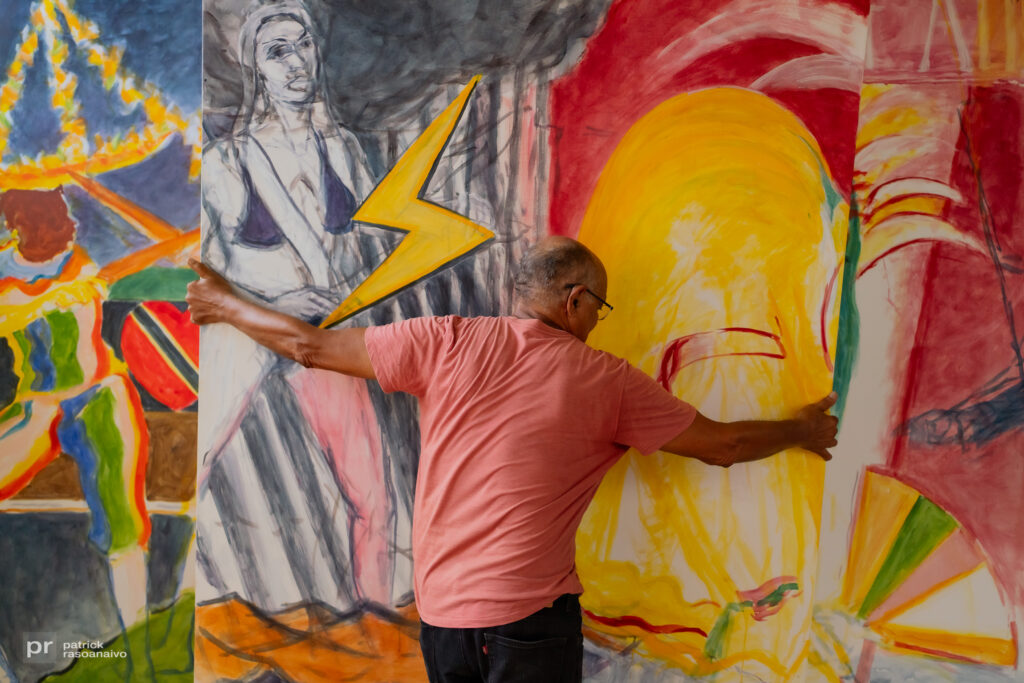
AG: What’s your evaluation of the art landscape or artscape in Trinidad and Tobago over the past 60 years?
JH: What is wonderful is how many more people now produce art (at whatever level), collect art (private and corporate), easily access images and information on world art, study art here and abroad, and exhibit. The National Museum and Art Gallery has changed very little physically and in its ability to attract a wider public but it is currently being renovated so hopefully it will soon be an even more dynamic institution. There are many many more exhibition spaces and galleries now than 60 years ago. The Central Bank has a growing collection of local art. The internet makes it far easier now to communicate and advertise. Yet, with all these advantages, it seems to me that meaningful communication with and education of the public have deteriorated.
Last of all, social media for me is a change from 60 years ago…For what it’s worth, like most artists, I’ve been able to exploit its obvious advantage of facilitating instant and very wide communication, advertising and displaying of Art. On the other hand it also gives power to those pretending to be knowledgeable about art to publicly push their agendas or biases.

AG: What are your deepest desires for the development of the Art world here in Trinidad & Tobago?
JH: I have always told myself that I must be dependent on no one, on nothing else, for the development of my career as an artist. But clearly there are areas outside of my control that would greatly help the development of artists and the Art landscape. I have already mentioned some above:
- A comprehensive, exceptionally designed National Museum and Art Gallery that would focus on attracting the general public and making art education a priority.
- A far, far more dedicated policy from the Media (press, TV etc) in promotion of visual Art, that would contribute towards an educated and knowledgeable public.
- Concessions (taxes etc) that would make the unavoidable importation of art materials less costly for all artists.
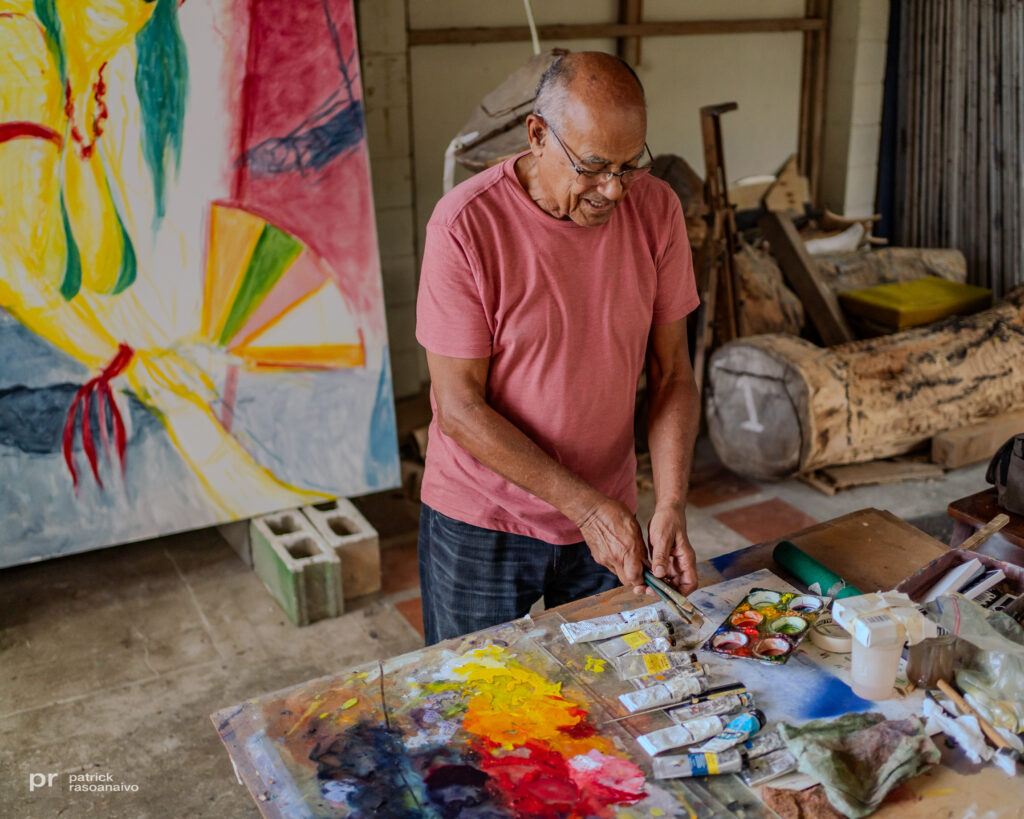
AG: What are some tips/ pointers for younger artists and anyone who wants to pursue Art as a career?
JH: Be prepared to work for your entire life.
Look at art from all eras and societies.
Draw, draw, draw nonstop.
Follow your instincts, be wary of philosophies that tell you what direction you must take
Do not rush to exhibit and if exhibiting do so with a group.
Never stop observing the world.
BIO
Jackie Hinkson (B. 1942, Trinidad & Tobago)
Hinkson pursued his art studies at the Academie Julián, Paris in 1963 and at the University of Alberta, Canada, 1965 to 1970, where he graduated with a BFA and a Diploma of Education. Since 1970 Hinkson’s style has remained mostly realistic and figurative but often with a strong sense of the abstract. He has worked in sculpture; crayon, charcoal and ink drawings; oils; murals; iPad drawings; and stage design for his longtime friends and admirer Derek Walcott for the musical “Steel”. His subjects range from landscape to architecture, the human figure in all aspects of national life, and social commentary. “Though influenced by classical European art, Jackie Hinkson is best known for his plein-air tropical watercolours. His long-practised and instantly recognisable technique allows him to render landscapes and swiftly and masterfully as abstract shapes of light and shade, which also retain the appeal of traditional scenes.” (Source: A-Z of Caribbean Art, Archer and Brown, 2019)
Jackie Hinkson has exhibited locally, regionally and internationally with a major retrospective in 2012. He has produced four books on his life and art. His over 100 sketch pads have been inscribed by UNESCO into Trinidad and Tobago’s Memory of the World register 2010. In 2011 the University of the West Indies conferred upon him an Honorary Doctorate. In 2019 the Republic of Trinidad and Tobago conferred upon him the Chaconia Medal Gold. Jackie Hinkson married Caryl Blache-Fraser in 1967 and has three children and nine grandchildren. Hinkson has been working as a professional artist since 1970, and is based in Trinidad & Tobago.
Biography courtesy the artist.
Photography by Patrick Rasoanaivo
